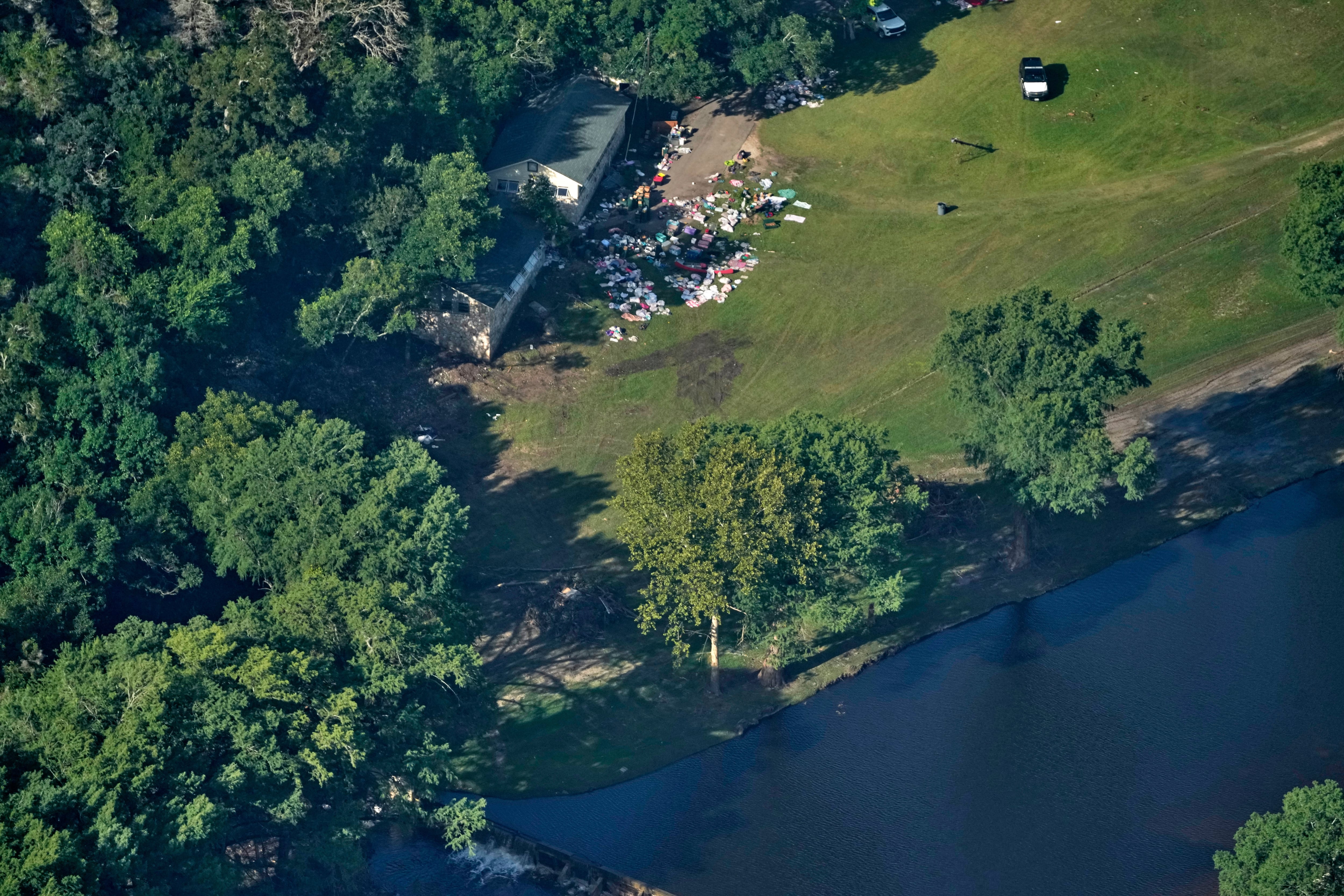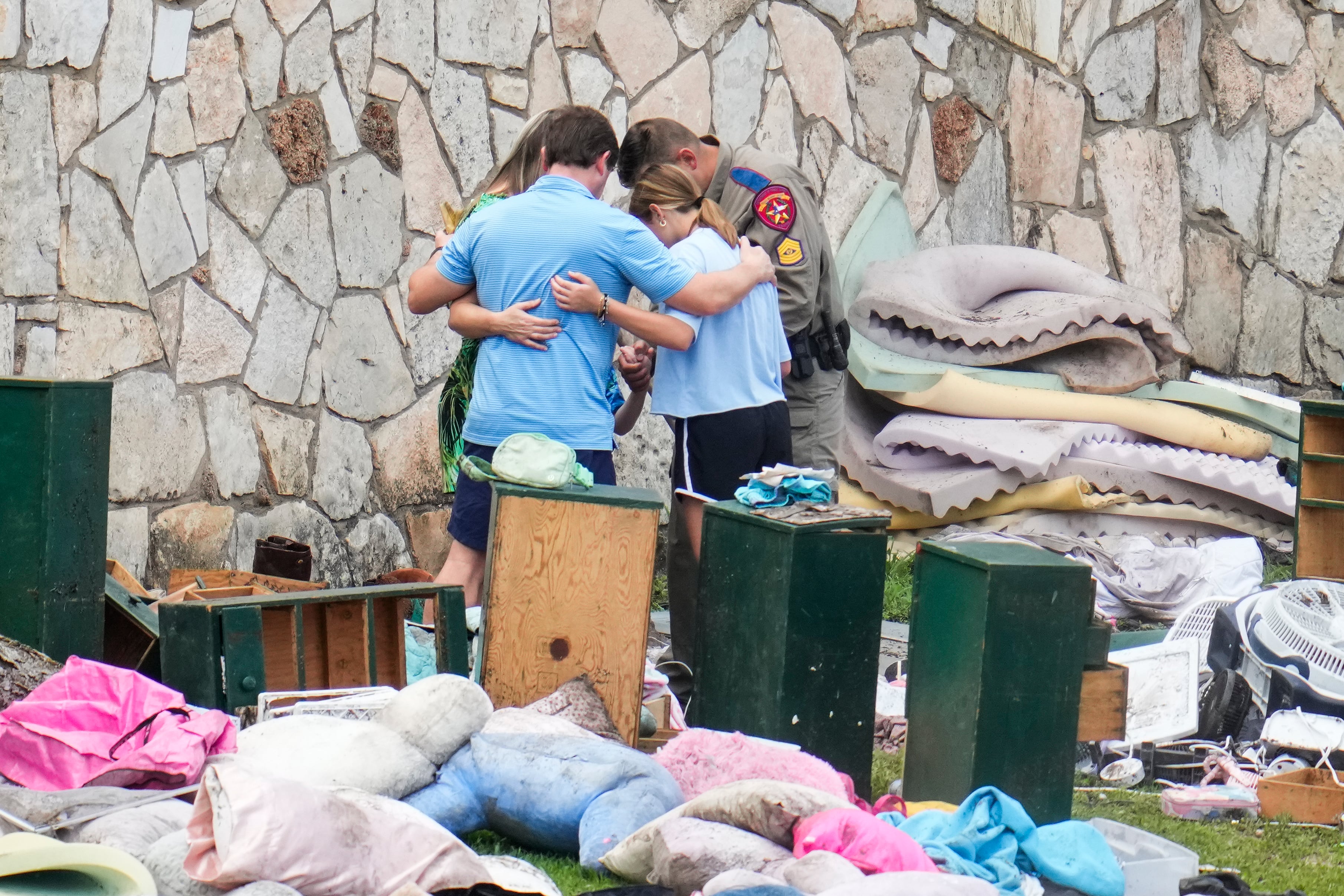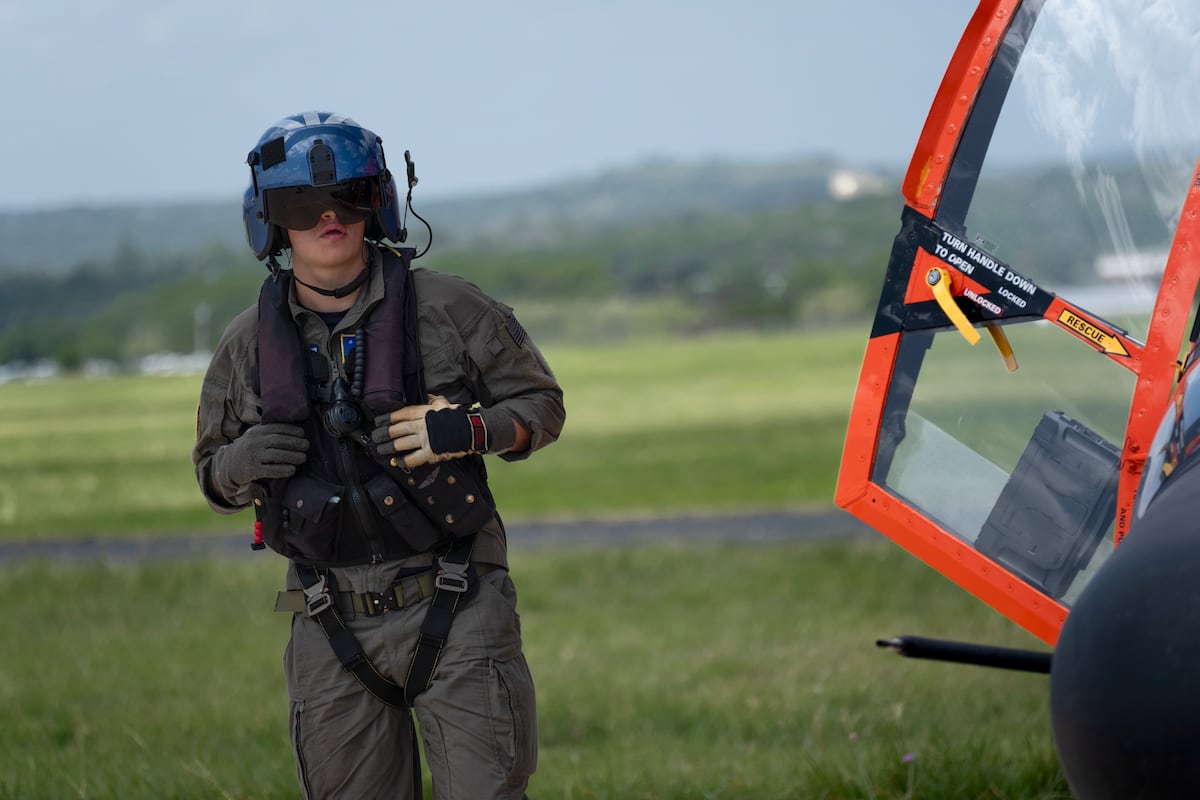Seth Reeves was only supposed to be at U.S. Coast Guard Air Station Corpus Christi, Texas, for two weeks.
He was slated to work from July 1 to July 15 as part of the Aviation Training Center’s flight mechanic exchange program, which allows guardsmen to stand duty at operational air stations. He had become a third-class aviation maintenance technician just over one year ago, in March 2024.
But on July 4, disaster struck, and Reeves — along with three other Coast Guardsmen from Coast Guard Rescue 6553 — found themselves in a treacherous search-and-rescue mission to save hundreds of stranded girls from Camp Mystic in Kerr County, Texas, after historic flooding tore through the Central Texas region.
The Guadalupe River swelled to a record-setting 37 feet, decimating the all-girls Christian summer camp and sweeping away campers and counselors along with it.
State officials confirmed that a known 136 people in Texas Hill Country died during the natural disaster, including 27 from Camp Mystic.
Coast Guard crews assisted local and state authorities to rescue 230 people, the service said.
Reeves, for his “actions and aeronautical skill” as part of the evacuation efforts, received an Air Medal from Homeland Security Secretary Kristi Noem on July 11. He was promoted to second class the same day.
But as the rain fell in sheets over Central Texas during the early morning hours of July 4, Reeves and the rest of the crew, more than 100 miles away, had no idea what lay ahead.
Before sunrise
The call came in early.
Pilot Lt. Ian Hopper briefed Reeves, co-pilot Lt. Blair Ogujiofor and rescue swimmer Petty Officer 3rd Class Scott Ruskan about severe flooding in the town of Kerrville, Texas.
They knew people were stranded on a campground near the Guadalupe, but they didn’t know how many.
Reeve’s initial thought was there might be three to four families, or maybe an RV park, he recalled.
The crew was operating off limited information. And the mission’s first hiccup came before they even got off the ground.
As they prepped, the crew detected a problem with the high-frequency radio in their MH-65E Dolphin helicopter.
They’d be traveling about 150 nautical miles inland to Kerr County, and communication would be key. They quickly switched to another MH-65E Dolphin.
The crew also decided to travel light and ditch a life raft to shave off 20 pounds of weight. That would earn them five to ten more minutes of fuel, Reeves said.
It was still dark out when they took off from Air Station Corpus Christi and headed toward the campground.
First try
The weather was bad from the start, Reeves said.
As the sun rose and they moved inland, closer to San Antonio, conditions got progressively worse.
Cloud cover dropped from 1,000 feet to somewhere between 200 to 300 feet about 45 minutes into the trip.
As they navigated through severe weather conditions, the crew operated off a visual flight rules plan, meaning the guardsmen still glanced at their instruments — but primarily relied on their eyes — to clock surroundings outside the aircraft.
This tactic required flying very close to the ground where visibility was best.
Elevation also became a problem.
Corpus Christi was flat, but as the crew moved north, they encountered the terrain of Hill Country, named for the region’s rolling hills and rugged rock formations. Eventually, the hills reached so high the helicopter had to climb above the clouds to avoid them.
And then things got dicey. They found themselves facing zero visibility with no visual reference.
The crew rapidly ascended to higher elevation in order to switch to instrument flight rules while establishing their location with air traffic control. Though they train for it, the circumstances were less than ideal.
“It’s one of the most dangerous things that could possibly happen,” Reeves said. “It’s not a situation anybody wants to be in.”
The crew decided to divert the aircraft to San Antonio to land, refuel and recalibrate.
Second attempt
On the ground, members of the 6553 decided they’d fly into Kerrville-Kerr County Airport, instead.
Air traffic control told them the weather over Kerrville looked as if it might shift northeast and let up slightly.
Reeves and the other crew members checked their radar and saw the same thing air traffic control did — a hole opening up for them to shoot an approach into the airport.
They took off again, this time relying on their flight instruments.
But as they neared their destination, air traffic control told them the weather wasn’t shifting — precipitation remained extreme.
Cloud ceilings over the airport sat at 100 to 300 feet. They couldn’t get a solid visual of the ground to land the helicopter. And because they were above cloud cover and relying on instrument flight rules, they also couldn’t rely on the aircraft to land itself safely.
“It was kind of a nightmare to try to shoot an approach into there,” Reeves said.
The crew decided to remain in a holding pattern, doing circles in the air 30 nautical miles south of the airport, waiting for a slot to open up for them to descend.
The slot never came. The weather kept holding.
“If you look at the radar itself, from late into the night to, you know, almost all day, that weather was just sitting over top with, maybe, I would say, like a 50-foot shift every hour,” Reeves said.
Ten to 15 minutes passed. No opportunities opened up.
The crew shifted their plan once again.
They went back to visual flight rules and began working their way toward South Texas Regional Airport in Hondo, Texas, southwest of Kerrville. There, they’d top off their gas and wait out the weather.
But they needed a plan to get there safely.
They decided Hopper would hand-fly the aircraft — few instruments, mostly manual — while Ogujiofor checked displays inside the cockpit for obstructions like power lines, telephone poles and cell towers. Ruskan checked radar to avoid extreme weather, and Reeves looked at Google Maps and Apple Maps for navigation.
“We drove the aircraft, like, on a road,” Reeves said. “We followed the highway all the way to Hondo with following all the bends, that way we could just stay visual with the ground.”

They flew at low altitude, slicing through the hills.
After two and a half hours of flying altogether, they made it to Hondo.
As they descended, they saw about a half-dozen Army National Guard helicopters grounded, waiting for the weather to let up before taking off.
Once they landed, the Coast Guard crew regrouped with the Army National Guard’s Alamo Area Search and Rescue, which was in touch with individuals on the ground at Camp Mystic. They received their final brief.
At that point, the 6553 learned its specific mission: The crew would be traveling directly to Camp Mystic to help rescue hundreds of girls who were stranded and at risk of being swept away by the water.
“That’s when I kind of like, OK, this is not, you know, one or two families at a campground, this is way more severe,” Reeves said.
The crew took off, leading the National Guard’s Alamo Area Search and Rescue to the location. Again, they relied on hand-flying and Google Maps.
At some points, they had to duck down to as low as 100 feet above the ground to carve their way through valleys and hills.
Finally, they approached a small, privately owned airport over the hill of Camp Mystic. They’d been flying for four and a half hours.
The helicopter’s traffic collision alert system pinged nonstop as they descended into the area. Fourteen other helicopters were flying around Kerr County to assist with rescue efforts.
The cramped air space was unnerving, Reeves remembered.
“It’s a super uncomfortable feeling with all these other aircraft in the air,” Reeves said. “We understand the situation, we train for the situation, but it’s kind of like we’re out of our ball game when it comes to a bunch of other aircraft assisting.”
The rescue
Despite having traveled for nearly five hours, the rescue mission was just beginning.
The crew devised a plan, listening to their radio to know where the girls were and where they should take them.
The whole camp was flooded, and the roads on both sides were washed away with rising water racing over them. The only way in or out was via helicopter.
The floodwaters had receded from higher ground and created a new river that cut through the middle of the camp. The girls were split in half as a result, Reeves said, leaving 300 to 400 campers stranded on the north side, where the Coast Guard executed their landing.

The ground was heavily saturated with water. To ensure the helicopter wouldn’t get stuck, Reeves poked his head out to watch as the aircraft gingerly rested its tires on the ground.
After the tires came the nose, and then the crew slowly reduced power to see how the helicopter was holding on the ground.
Reeves said it was a routine maneuver they practiced many times. The tires didn’t sink, and Reeves let Hopper know the aircraft was alright.
They elected to leave Ruskan on scene to work triage for all the girls.
The severity of the situation really hit Reeves the moment a growing stream of young girls, upon hearing the helicopter that signaled their rescue, left the confines of their cabins “almost like a river themselves,” he said.
“And it’s just hundreds of girls coming out of these cabins, waving their arms.”
It was clear they’d been stranded since 1 a.m., Reeves said.
A trained EMS, Ruskan joined with counselors and hundreds of girls about 50 yards away from the helicopter. He decided which ones needed medical attention first, communicating with the aircraft via radio.
The rescue had officially begun.
The aircraft could carry only four girls at a time without Ruskan on the helicopter. After loading them in, the crew dropped the girls off at Ingram Tom Moore High School, the collection point a couple miles up the river on higher ground.
Paramedics and law enforcement waited on the training football field, Reeves said, checking girls’ vitals before placing them on school buses to be moved to another location.
Many of the girls had never flown on a helicopter before and were terrified of the loud machinery, Reeves said.
He handed out foam hearing protection before they boarded the aircraft. Then, he buckled the girls into waist-restraint systems and five-point harnesses for their trip out of Camp Mystic.
By the time the 6553 was relieved and swapped out with a different crew (crews can only work so long, even with the two waivers they were given), the guardsmen had flown 8.2 hours.
Despite all the hours, it was difficult to walk away from the rescue, Reeves said.
“It’s hard, especially with young kids, to not feel emotional,” he said. “Some of these girls are having the worst day of their life. And it’s very evident when they’re coming on the aircraft that these girls have seen peers of theirs, counselors and sisters of theirs be swept away by the raging waters of the river and it’s all over their face.”
Every time the helicopter left with a group of girls, those remaining on the ground would wave at the aircraft as it rose into the sky. The girls inside the helicopter were so devastated they often didn’t notice.
Reeves would encourage them, “Hey, wave to your friends.” Each time, the girls would look outside, see their friends and return their waves.
That courage stayed with Reeves.
“Everyone wants to say that, you know, these girls were helpless,” he said. “In some parts they definitely were, but a lot of parts, they stayed super strong.”
Riley Ceder is a reporter at Military Times, where he covers breaking news, criminal justice, investigations, and cyber. He previously worked as an investigative practicum student at The Washington Post, where he contributed to the Abused by the Badge investigation.
Read the full article here








